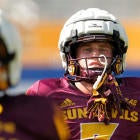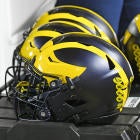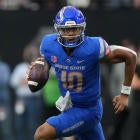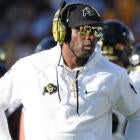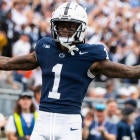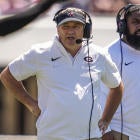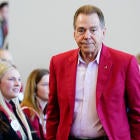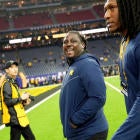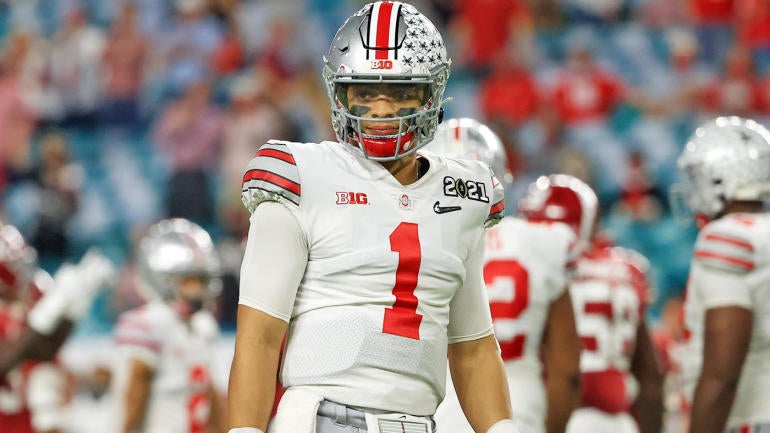
The NFL Draft will commence on Thursday night, and when it does, Clemson's Trevor Lawrence will be selected by the Jacksonville Jaguars with the first pick of the draft. After Lawrence, most people seem to believe BYU's Zach Wilson will be the next name off the board, chosen by the New York Jets.
The question, however, is: should they be taken in those slots?
There's nothing more difficult in football than evaluating quarterbacks and how well they will translate from the college level to the NFL level. It's about so much more than size, talent or production. Still, that hasn't stopped people from trying to streamline the process because the QB is the most important position in the game. Landing the right one can change a franchise -- just ask the Tampa Bay Buccaneers or Kansas City Chiefs.
For the last decade, I've tried to develop a way to predict the likelihood of NFL success for college QBs using their production at the college level. I haven't found it yet. Believe me, if I had, I wouldn't be writing about it here. I'd be charging an NFL team a ridiculous amount of money for the information.
Want more college football in your life? Listen below and subscribe to the Cover 3 College Football podcast for top-notch insight and analysis beyond the gridiron.
So how do I do it? Well, I break down each QB's -- using the list of QB prospects on NFL.com's draft page -- performances at the college level in three separate areas: against top 50 SP+ defenses, on third-and-long (7 yards+) and in the red zone. These are the situations I believe are more "translatable" to what a QB will face in the NFL regularly. I then plug the numbers into a formula I've created and, voila, I get the scores.
The results are not perfect. They aren't even close. One flaw of my system is it doesn't include a QB's running statistics, which is by design. While the ability to run is important for any QB, the bulk of their career will still be determined by their passing, and I'm trying to determine a player's potential as a passer.
Another problem is that the sample size varies. A QB who spent his entire career in a Power Five conference is far more likely to face top 50 defenses than guys at the Group of Five. Also, unfortunately, you won't see North Dakota State's Trey Lance in these rankings. I do not have the same kind of access to reliable data at the FCS level that I do FBS.
As for how accurate the ratings are, it depends on your perspective. Predicting success based on the best scores is hit-or-miss. Where my system seems to shine is predicting which QBs will not succeed. You don't often see players with below-average scores in my ratings going on to have a lot of NFL success.
Here is how the 14 QBs of the 2021 class that I rated rank compared to one another. Their Fornelli Rating reflects how far above the average score for the 2021 class they finish. In other words, Justin Fields was 8.11% better than the average QB in 2021. I use this method of comparing the players to their class because offenses at the college level change and passing numbers are improving astronomically, so it's a way to compare the players across seasons more accurately.
| Rank | Quarterback | School | Fornelli Rating | 2020 Stats |
|---|---|---|---|---|
1. | Justin Fields | 8.11% | 2,100 yards, 22 TD, 6 INT | |
2. | 4.71% | 4,500 yards, 41 TD, 4 INT | ||
3. | 3.77% | 1,508 yards, 7 TD, 3 INT | ||
4. | 3.46% | 4,283 yards, 43 TD, 8 INT | ||
5. | Trevor Lawrence | Clemson | 3.16% | 3,153 yards, 24 TD, 5 INT |
6. | Zach Wilson | BYU | 2.87% | 3,692 yards, 33 TD, 3 INT |
7. | 1.63% | Did Not Play | ||
8. | -0.39% | 3,380 yards, 31 TD, 10 INT | ||
9. | -1.41% | 2,566 yards, 26 TD, 5 INT | ||
10. | -1.59% | 2,830 yards, 15 TD, 3 INT | ||
11. | -4.01% | 2,107 yards, 17 TD, 4 INT | ||
12. | -6.14% | 1,733 yards, 12 TD, 8 INT | ||
13. | -6.26% | 3,095 yards, 23 TD, 6 INT | ||
14. | -7.90% | 2,282 yards, 19 TD, 3 INT |
How does this class compare historically? Fields is the only one to crack the top 10 all-time (all-time being since I began tracking in 2012), and Mac Jones is the only other QB in this class to crack the top 20.
| Rank | Quarterback | Fornelli Rating |
|---|---|---|
1. | Tua Tagovailoa | 13.71% |
2. | Andrew Luck | 9.75% |
3. | Dwayne Haskins | 9.52% |
4. | Kyler Murray | 9.43% |
5. | Johnny Manziel | 8.98% |
6. | Robert Griffin | 8.67% |
7. | Baker Mayfield | 8.22% |
8. | Justin Fields | 8.11% |
9. | Mitch Trubisky | 8.11% |
10. | Jameis Winston | 6.88% |
11. | Sam Darnold | 6.50% |
12. | Marcus Mariota | 6.23% |
13. | Logan Woodside | 6.19% |
14. | Jared Goff | 5.62% |
15. | Patrick Mahomes | 5.57% |
16. | Blake Bortles | 4.89% |
17. | Jake Fromm | 4.80% |
18. | Mac Jones | 4.71% |
19. | Deshaun Watson | 4.62% |
20. | Cooper Rush | 4.56% |
Where this class stands out is at the bottom, as three of the 14 finish in the bottom 10 all-time.
| Rank | Quarterback | Fornelli Rating |
|---|---|---|
1. | -8.59% | |
2. | Nick Fitzgerald | -7.96% |
3. | Kellen Mond | -7.90% |
4. | -7.18% | |
5. | J'mar Smith | -6.64% |
6. | Shane Buechele | -6.26% |
7. | -6.21% | |
8. | Peyton Ramsey | -6.14% |
9. | Tanner Lee | -6.11% |
10. | James Morgan | -5.71% |
Now, let's dive into some specifics.
What happened to Trevor Lawrence?
While I'm not all that worried about it, Lawrence's overall score is due to his performance in third-and-long/fourth-down situations. His score ranked ninth overall of the 14, but I'm not sure Lawrence should shoulder the blame. Alabama will have two receivers selected in the first round this year. It had two taken last season, as well. The last Clemson receiver to go in the first round was Mike Williams in 2017, a year before Lawrence showed up. He just hasn't had the same kind of weapons around him at Clemson that Mac Jones had at Alabama or Justin Fields had at Ohio State. While that alone doesn't excuse the performance, it certainly didn't help.
OK, but Davis Mills? Seriously?
Yeah, there's some sample size at work here. While Lawrence struggled in third-and-long/fourth-down situations, Mills dominated them. He finished first among our QBs, just ahead of Justin Fields and far ahead of everybody else. But Mills didn't throw many passes in those situations. In fact, he threw only 54 passes in such situations. For context, Lawrence threw 48 passes in that situation in 2020 alone and 161 in his career. That's not to say Mills was bad everywhere else; he finished fifth against top defenses. Where he struggled was in the red zone, where his score finished 10th overall.
How good is Justin Fields' score?
It's very good. While he's not cracking the top five all-time, there aren't any weak spots in his game compared to his 2021 compatriots. Some are better than him in individual spots, but when it comes to the complete picture, he was consistent, finishing second against top defenses, second in third and fourth-down situations and third in the red zone.
What about Zach Wilson?
Wilson's challenging to get a read on because he didn't face many top defenses during his college career. Making it more difficult -- most of the top defenses he faced were in 2019 and before. His numbers took a significant leap in 2020 as BYU played an easier schedule, so there are certainly some question marks. That said, Wilson's performance in third and fourth-down situations and the red zone was solid. That tends to bode well for future performance.
Final thoughts
I want to stress that while this is my ranking system, these are not necessarily my personal rankings. This is what the numbers say, and the numbers are only part of my evaluations. If I were a general manager, my draft board would look like this at QB.
1. Trevor Lawrence
2. Justin Fields
3. Mac Jones
4. Zach Wilson
5. Kyle Trask
Also, I feel it's important to point out that Fields is closer to Lawrence on my board than Mac Jones or any other QB in this class are to Fields in my valuation. This is a two-quarterback class as far as I'm concerned. I believe both Lawrence and Fields can be franchise QBs, while everybody else can be a good NFL player if they end up in the right situation.













